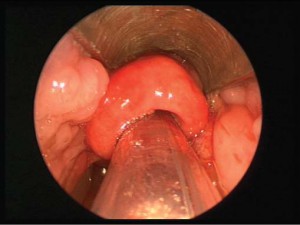Epiglottitis
Epiglottitis was once a very serious childhood disease. Epiglottitis is an inflammation of the epiglottis caused by a bacterial infection, typically by type B Hæmophilus influenzæ. Created edema can, in the worst cases lead to obstruction of the larynx and asphyxia. Treatment for epiglottitis in children has evolved in recent decades, from tracheotomy to intubation by rigid bronchoscope, then finally to nasotracheal intubation in the operating room.

In children, epiglottitis is usually manifested by a sore throat accompanied by stridor, sialorrhea (drooling), a hushed voice, and ultimately breathing difficulties. The child sometimes takes the classic position of the tripod, sitting, leaning forward, arms stretched apart forward, allowing freeing the upper respiratory tract.
The child usually refuses to lie down. It is important to remember that although it is now very rare, epiglottitis in children is no less threatening. Consequently, when great doubt, we must avoid any action that could cause anxiety or compromise the airway.
In adults, it is more considered a supraglottitis than a forthright epiglottitis. The clinical picture will be different. The adults complain of odynophagia, sore throat and neck pain. Stridor and dyspnea are much rarer signs but are alarming when present. Finally, all suffering from epiglottitis patients must receive intravenous antibiotics.
Reference: Le Médecin du Québec, Volume 42, Number 5, May 2007
__________________________
Emergency in ENT
Peritonsillar abscess
Ludwig’s Angina
Foreign body in the ear
Foreign body in the respiratory tract (nose, trachea, bronchi)
Foreign body in the esophagus
Epiglottitis
Epistaxis
Perilymphatic fistula
Nose fracture
Hemorrhage post-adenotonsillectomy
Acute mastoiditis
Facial paralysis
Sudden hearing loss
